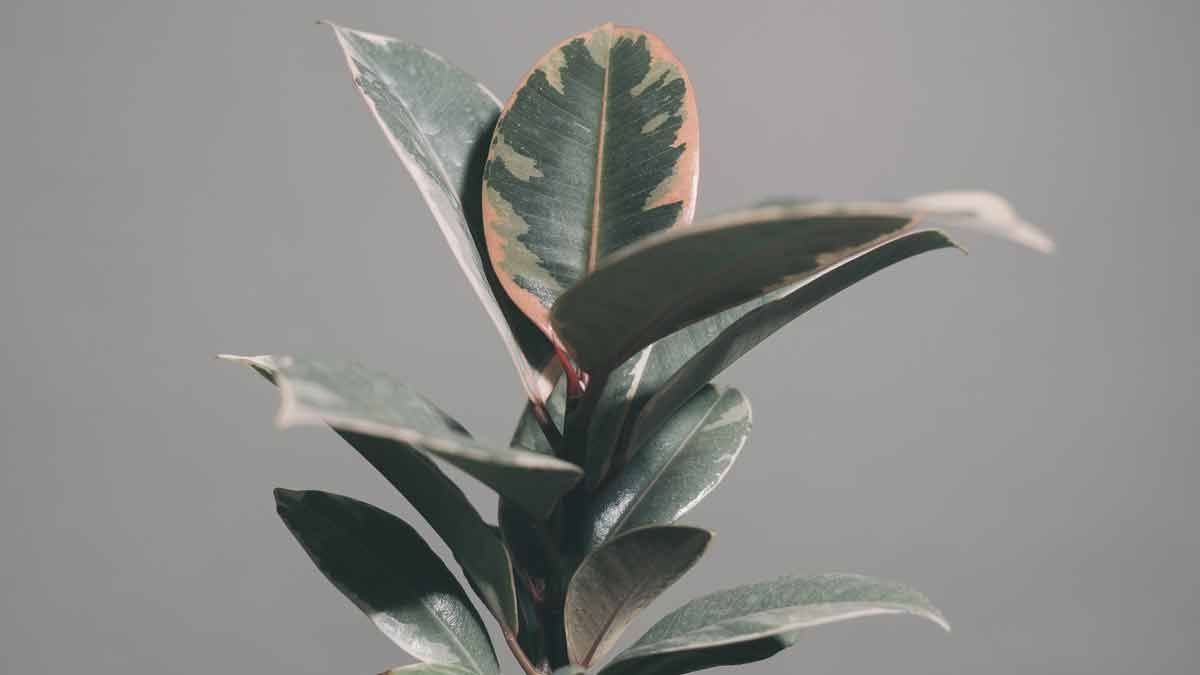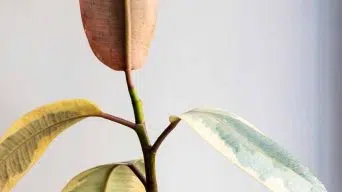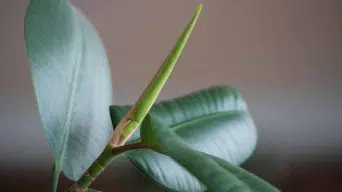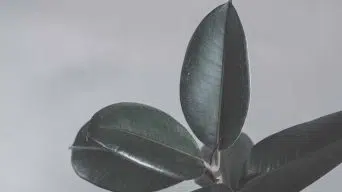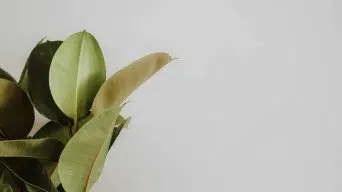Ficus elastica, or the rubber plant, is a popular houseplant known for its glossy, dark green leaves.
Though it is a tough plant that can tolerate neglect, it can still experience problems from time to time.
One common issue is leaves falling off the rubber plant.
There are a few reasons your rubber plant’s leaves may be falling off, and, fortunately, there are also a few simple solutions.
This article will explore why rubber plant leaves fall off and what you can do to fix the problem.
What Causes Rubber Plant Leaves to Fall Off
Falling leaves are often one of the first signs that something is wrong with a plant.
In the case of the rubber plant, falling leaves can be caused by a variety of issues, including:
1. Overwatering
Overwatering is one of the most common reasons for dropping leaves on a rubber plant.
Rubber plants are native to tropical regions and do not like to be in standing water.
Instead, they prefer to be in moist soil that drains well.
If you notice that your rubber plant leaves are drooping and the soil is wet or soggy, you are likely overwatering your rubber plant.
You will need to water your rubber tree plant less frequently to fix this problem.
It is also a good idea to check your pot’s drainage to ensure that the water is not pooling at the bottom.
2. Underwatering
Though overwatering is a common problem, underwatering can cause rubber plant leaves to drop.
If the leaves on your rubber plant are wilting and turning yellow, likely, they are not getting enough water.
To fix an underwatered rubber plant, you must water your rubber plant more frequently.
Rubber plants should generally be watered once a week, though they may need more water in hot or dry conditions.
3. Nutrient Deficiency
Another common reason for rubber plant leaves to fall off is nutrient deficiency.
Rubber plants need nutrients to stay healthy, including nitrogen, phosphorus, and potassium.
If your rubber plant is not getting enough of these nutrients, the leaves may turn yellow and eventually fall off.
To fix this problem, you will need to fertilize your rubber plant.
Rubber plants should be fertilized once a month during the growing season.
4. Pests
Pests can also cause rubber plant leaves to fall off.
If your plant’s leaves are turning yellow or brown and falling off, they are likely being eaten by pests such as aphids, mealybugs, or scale insects.
Treat your plant with insecticidal soap or neem oil to eliminate pests. These products are safe for houseplants and will not harm humans or animals.
5. Diseases
Diseases can also cause rubber plant leaves to fall off.
Root rot and leaf spot are the most common diseases affecting rubber plants.
Rubber plant root rot is caused by overwatering and can be challenging to fix.
Reducing watering frequency is essential in preventing the rot of the rubber plant roots.
Leaf spot is a fungal disease that can be treated with fungicidal soap or neem oil.
Although leaf spot is not as severe as root rot, it can still cause your plant’s leaves to fall off if not treated.
6. Temperature Stress
Temperature stress can also cause rubber plant leaves to fall off.
Rubber plants are native to tropical regions and prefer warm, humid conditions.
If the temperature drops below 60 degrees Fahrenheit, the leaves of your rubber plant may turn yellow and fall off.
To prevent this, you will need to ensure that your plant is in a warm, humid environment.
If the temperature in your home is too cool, you can raise the temperature by using a space heater or placing your rubber plant near a radiator.
You can also increase the humidity around your plant by misting it with water or placing it on a pebble tray.
7. Transplant Shock
Transplant shock can also cause rubber plant leaves to fall off.
This is a common problem when plants are moved from one pot to another.
The roots are disturbed when a plant is transplanted, and the plant goes into shock.
As a result, the plant leaves may turn yellow and fall off.
To prevent transplant shock, you must be careful when transplanting your rubber plant.
Ensure that the new pot is not too big or too small and that the roots are not disturbed more than necessary.
8. Not Enough Light
Not enough light is another common reason rubber plant leaves fall off.
Rubber plants need bright indirect light to stay healthy.
If your plant is not getting enough light, the leaves may turn yellow and eventually fall off.
You will need to move your rubber plant to a brighter location to fix this problem.
If you cannot provide your plant with enough light, you may need to supplement the light with grow lights.
9. Too Much Sunlight
Although rubber plants need bright light, too much sunlight can cause the leaves to fall off.
If the leaves of your plant are turning brown or yellow and falling off, they are likely getting too much sun.
To fix this problem, you must move your rubber plant to a location with less direct sunlight.
You can place it in a spot that gets bright indirect sunlight or in an area that gets dappled sunlight.
10. Draughts
Draughts can also cause rubber plant leaves to fall off.
Rubber plants are sensitive to draughts; the leaves may turn brown and fall off if exposed to too much wind.
To prevent this, you must ensure that your plant is not in a spot that gets a lot of draft.
You can also help protect your plant from draughts by placing it in a spot that is out of the way of doors and windows.
11. Poor Soil
Poor soil can also cause rubber plant leaves to fall off.
Rubber plants need well-drained, nutrient-rich soil to stay healthy.
If the soil is too heavy or too sandy, the roots of your plant will not be able to get the nutrients they need, and the leaves may turn yellow and fall off.
To fix this problem, repot your rubber plant in a potting mix that is well-drained and contains nutrients.
You can also add compost or organic matter to the soil to improve its quality.
12. Chemical Burns
Chemical burns can also cause rubber tree plant leaves to fall off.
If you use too much fertilizer or if the fertilizer you are using is too strong, it can burn the roots of your plant.
As a result, the leaves of your plant may turn yellow and fall off.
To prevent this, you must be careful when fertilizing your rubber plant.
Make sure you use a fertilizer designed for rubber plants and not more than the recommended amount.
13. Natural Leaf Drop
In some cases, leaf drop may be natural and not caused by a problem with your plant.
Rubber plants are deciduous and, naturally, lose their leaves in the fall and winter months.
Lower leaves will also naturally fall off as new growth appears.
If your plant is losing a few leaves, this is not a cause for concern.
However, losing many leaves may be a sign of a problem if your plant is losing many leaves.
What To Do If Your Rubber Plant Leaves Are Falling Off
If the leaves of your rubber plant are falling off, you will need to take action to save your plant.
Here are a few things you can do if your rubber plant leaves are falling off:
1. Check The Soil
The first thing you should do if your rubber plant leaves are falling off is to check the soil.
Make sure that the potting mix is well-drained and contains nutrients.
If the soil is too heavy or too sandy, you must repot your plant in a better potting mix.
You can also add compost or organic matter to the soil to improve its quality.
2. Check The Light
The next thing you should do if your rubber plant leaves are falling off is to check the light.
Rubber plants need bright light, but too much sunlight can cause the leaves to fall off.
If your plant is in direct sunlight, you will need to move it to a location with indirect light.
You can place it in a spot that gets bright indirect light or in an area that gets dappled sunlight. An east-facing window is a good spot for a rubber plant.
3. Check The Temperature
The next thing you should do if your rubber plant leaves are falling off is to check the temperature.
Rubber plants prefer warm temperatures and will not do well in cooler environments.
If the temperature in your home is below 65 degrees Fahrenheit, your plant may be experiencing stress, and the leaves may fall off.
To fix this problem, you will need to raise the temperature in your home or move your plant to a warmer location.
4. Check The Humidity
The next thing you should do if your rubber plant leaves are falling off is to check the humidity.
Rubber plants prefer humid environments but will not do well in dry climates.
If the air in your home is too dry, the leaves of your plant may turn brown and fall off.
To fix this problem, you will need to increase the humidity around your plant.
You can do this by placing a humidifier near your plant or using a pebble tray.
A pebble tray is a tray filled with pebbles and water.
You can place your plant on top of the tray, and the evaporation of the water will increase the humidity around your plant.
5. Check The Fertilizer
The next thing you should do if your rubber plant leaves are falling off is to check the fertilizer.
As we mentioned earlier, too much fertilizer can burn the roots of your plant and cause the leaves to fall off.
To fix this problem, you must be careful when fertilizing your rubber plant.
Make sure you are using a balanced fertilizer and not using more than the recommended amount.
6. Check For Pests
The next thing you should do if your rubber plant leaves are falling off is to check for pests.
Rubber plants are susceptible to pests such as spider mites, mealybugs, and scale insects.
These pests can suck the nutrients out of your plant and cause the leaves to fall off.
To fix this problem, you must scrutinize your plant and look for signs of pests.
If you see any pests on your plant, you must treat them with neem oil or insecticidal soap.
7. Check For Diseases
The next thing you should do if your rubber plant leaves are falling off is to check for diseases.
Rubber plants are susceptible to diseases such as root rot and leaf spot.
These diseases can cause the leaves of your plant to fall off.
To fix this problem, you must scrutinize your plant and look for signs of diseases.
If you see any diseases in your plant, you must treat them with the appropriate fungicide or pesticide.
8. Prune Your Plant
The next thing you should do if your rubber plant leaves are falling off is to prune your plant.
Pruning will help to remove any dead or dying leaves from your plant.
It will also help to encourage new growth.
To prune your rubber plant, you must use sharp pruning shears.
Make sure you make clean cuts and do not damage the stems of your plant.
9. Repot Your Plant
The next thing you should do if your rubber plant leaves are falling off is to repot your plant.
Repotting will help to aerate the roots of your plant, and it will also help to provide your plant with fresh soil.
To repot your rubber plant, you will need to choose a pot that is one size larger than the pot that your plant is currently in.
You will also need to use a fresh potting mix.
10. Give Your Plant A Timeout
The last thing you should do if your rubber plant leaves are falling off is to give your plant a timeout.
If you have been doing everything right and your plant is still not doing well, it may be time to give it a break.
Your plant may need some time to recover from the stress that it has been under.
With time and proper care, your plant will likely recover, and the leaves will stop falling off.
What Are The Benefits Of Rubber Plant Leaves Falling Off?
Are you wondering why your rubber plant’s leaves are falling off? Perhaps you think it’s because the plant is sick or something is wrong with your watering schedule.
But in fact, there are several reasons rubber plant leaves may fall off, and many of them benefit the plant!
One reason why rubber plant leaves may fall off is due to a process called self-pruning. This is when the plant sheds its oldest, toughest leaves to make room for new growth.
While it may seem bad at first, self-pruning is a good sign that your rubber plant is healthy and growing well!
Another benefit of rubber plant leaves falling off is that it can help the plant cope with stress.
If your rubber plant is exposed to too much direct sunlight, the leaves may start to fall off to protect themselves from further damage.
Similarly, if the plant is not getting enough water, the leaves will also fall off to prevent the plant from losing too much moisture.
In both cases, the leaves falling off is a good sign that the plant is healthy and trying to protect itself!
What To Do With The Rubber Plant Leaves That Fall Off
Now that you know why rubber plant leaves may fall off, you may wonder what to do with all the leaves that fall off!
One option is to compost them. The leaves make excellent compost material, which will help improve your soil’s quality!
Another option is to use the leaves as mulch.
Mulching with rubber plant leaves can help to suppress weeds, and it will also help to retain moisture in the soil.
Finally, you can also use the leaves as decoration!
The leaves are beautiful and a great addition to any home décor. You can use them to create wreaths, garlands, or even scatter around your plant’s base.
No matter what you do with them, rubber plant leaves are a great way to add a touch of nature to your home!
Final Thoughts
Ficus elastica, or rubber plants, are popular houseplants known for their glossy, thick leaves. They can grow large, making them a statement piece in any room.
If you notice your rubber plant dropping leaves, don’t panic!
There are a few possible reasons why this is happening, and with some care, you can get your plant back to its healthy self in no time.

